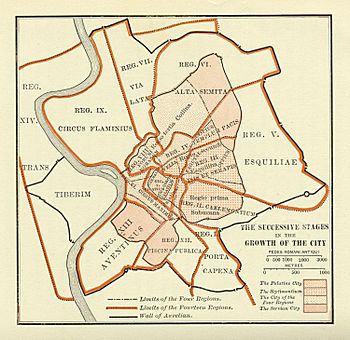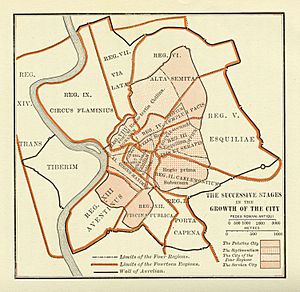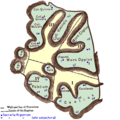Roman Kingdom facts for kids
Quick facts for kids
Roman Kingdom
Regnum Romanum
|
|||||||
|---|---|---|---|---|---|---|---|
| 753 BC–509 BC | |||||||

The ancient quarters of Rome.
|
|||||||
| Capital | Rome | ||||||
| Common languages | Latin | ||||||
| Religion | Roman Paganism | ||||||
| Government | Monarchy | ||||||
| King | |||||||
|
• 753–717 BC
|
Romulus | ||||||
|
• 535–510 BC
|
Lucius Tarquinius Superbus | ||||||
| Legislature | Roman Senate and Assembly | ||||||
| Historical era | Ancient | ||||||
|
• Founding of Rome
|
753 BC | ||||||
|
• Disestablished
|
509 BC | ||||||
|
|||||||
The Roman Kingdom (Latin: Regnum Romanum) was the first way Rome was ruled. It was a monarchy, meaning it had kings. This was before Rome became a Republic or a huge Empire.
We don't have many written records from this time. Most of what we know comes from stories and legends written much later. So, some parts of the Roman Kingdom's history are not fully certain.
The Roman Kingdom started when the city of Rome was founded, which people traditionally say was in 753 BC. It ended around 509 BC when the kings were removed, and the Roman Republic began.
| Top - 0-9 A B C D E F G H I J K L M N O P Q R S T U V W X Y Z |
How Rome Began
The great Roman Empire started as small settlements. These were built around the Palatine Hill near the Tiber River in central Italy. The river was easy to travel on up to this spot. There was also a shallow place where people could cross the Tiber.
The Palatine Hill and other hills nearby were good places to defend. They were surrounded by a wide, fertile plain. All these things helped the city of Rome grow and become successful.
Traditional Roman history says that Rome was ruled by seven kings in its early centuries. However, modern experts question this timeline. This is because Gauls destroyed Rome's historical records. They attacked the city after the Battle of the Allia in 390 BC or 387/6 BC. Because of this, we don't have any records from the time of the kingdom itself. This means we should be careful about all the stories we hear about the kings.
The Kings of Rome
According to legend, after Romulus, Rome had six more kings. These were Numa Pompilius, Tullo Ostilio, Anco Marzio, Tarquinius Priscus, Servius Tullius, and Tarquinius Superbus.
Romulus was the first king and he created the Senate. After Romulus died, the Senate chose the next king. They picked Numa Pompilius. Numa was different from Romulus; he preferred peace over war. Numa is also known for bringing religion into the daily lives of Romans.
The kings had a lot of power, almost absolute. But the Senate still had some influence. One important thing was that kingship was not hereditary. This means a son did not automatically become king after his father.
Choosing a New King
When a king died, Rome had a special period called an interregnum. During this time, the Senate took over the state's power. Their main job was to find a new king.
The Senate would choose one of its members to be an interrex for five days. This person's only job was to suggest a new king. If they didn't find one in five days, another Senator would become interrex for five more days. This continued until a good person was found.
Once the interrex found someone suitable, the Senate would check if they approved. If the Senate agreed, the interrex would then call an Assembly. The people of Rome would then vote to accept or reject the person.
If the people accepted the person, they still didn't become king right away. Two more steps were needed:
- First, the gods had to approve. An augur (a religious official) would perform a ceremony. If the gods gave good signs, it meant they approved of the new king. This was important because the king would also be Rome's high priest.
- Second, the king needed to be given imperium. This was the special power and authority of a king. The king-elect would ask the Assembly to grant him this power, and the Assembly would vote to give it to him.
So, in theory, the people of Rome chose their leader. But the Senate had a lot of control over who could be chosen.
Romulus, Rome's First King
Romulus was the first king of Rome and its founder. The city's name, Rome, comes from his name. In 753 BC, Romulus started building the city on the Palatine Hill.
After founding Rome, he welcomed all kinds of men to become citizens. This included slaves and free men, without any difference. To help his citizens find wives, Romulus invited nearby tribes to a festival in Rome. Romulus also shared his kingship with the Sabine king, Titus Tatius, for a time.
Romulus chose 100 of the best men to form the Roman Senate. This group was an important advisory council to the king. He called these men patres, and their families became the important patricians.
He also divided the general population into thirty curiae. These were named after thirty Sabine women who helped end a war between Romulus and Tatius. These curiae were the voting groups in the Roman assemblies.
Images for kids
See also
 In Spanish: Monarquía romana para niños
In Spanish: Monarquía romana para niños






